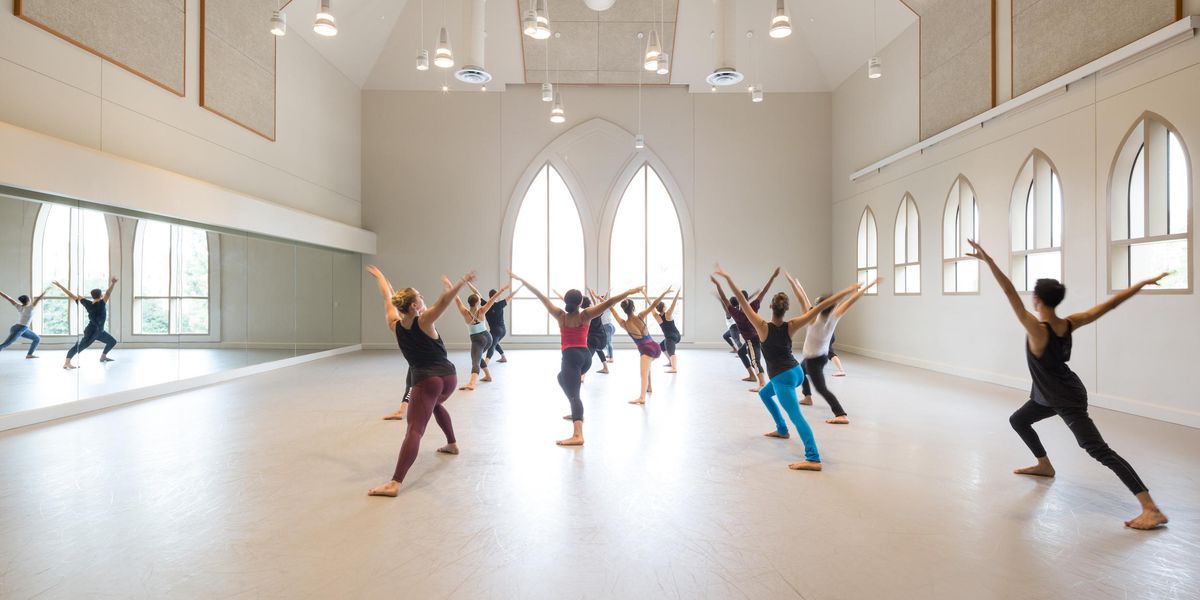Technique My Way: Belen Pereya
Ailey’s petite force
In Jirí Kylián’s
Petite Mort, with Jermaine Terry. Paul Kolnik, Courtesy AAADT.
In rehearsal for Ronald K. Brown’s Grace, Alvin Ailey’s Belen Pereyra cuts an unassuming figure in a black T-shirt and sweatpants. But the petite 25-year-old has an outsize presence, thanks to her crisp yet freewheeling style. In the pulsing, African-inspired sections, she seamlessly moves from liquid body rolls to gazelle-like leaps, revealing a sly sense of timing and level shifts. Later, she echoes the soulfulness of Duke Ellington’s “Come Sunday”—face to the heavens, forearms quaking with emotion.
Raised in Lawrence, Massachusetts, the Dominican-born Pereyra has a natural rhythm that’s in step with choreography like Grace. “I’m very influenced by merengue, bachata, salsa,” she says. “My style is everything groovy.” Other aspects of her work—from ballet technique to nutrition—are continual works in progress. Dance Magazine spoke with Pereyra before the company’s recent 21-city tour about how she stays grounded and rested, both physically and mentally. Not that there’s much downtime: This month, she’s back onstage in New York for Ailey’s seven-performance run at Lincoln Center. (See “New York Notebook,” p. 20.)
Positive Charge
Pereyra got her start with folkloric dancing, followed by ballet lessons at age 8. After relocating to New York, she danced with Camille A. Brown and apprenticed with Ronald K. Brown.
While she was in a work-study position at The Ailey School, a large Revelations photo in the lobby planted a seed in her mind. She doubled up on Ailey Extension classes in the two techniques that are essential to the company’s dancers: Horton and ballet. The latter was a particular area of focus for Pereyra. “Because of my hyperextension and tendency to arch, I used to grip everything,” she says, recalling that her early training left her without a clear understanding of placement and anatomy. To rebuild her foundation, she began studying with Gabriela Darvash, the famed ballet teacher, whose method stresses proper alignment rather than forced turnout and extensions. “Madame Darvash made sense out of the ballet world for me,” says Pereyra.
Feeling a renewed sense of hope, Pereyra gave herself a year to prepare for the Ailey audition. “Every day—from beginning to end—I zoned in on the idea that I was an asset to this company,” she says, “even though in the back of my mind I didn’t believe it.”
That positive thinking paid off. She joined the company in 2011, one of eight dancers selected by the incoming artistic director, Robert Battle.
Continuing Education
The learning curve has been steep, given the breadth of Ailey’s repertoire—fast-growing under Battle to include works by Paul Taylor, Ohad Naharin, Kyle Abraham, and Jirí Kylián. “You’ve got to move, learn it, get the style, and you’ve got to perform it tomorrow,” says Pereyra. “I’m growing in ways that I could have never imagined.”
On tour, she takes private ballet lessons with principal dancer Linda Celeste Sims, to continually fine-tune her sense of control. When she was cast in Hidden Rites, an Ailey classic steeped in Graham vocabulary, she sought out fellow company member Jermaine Terry for tutoring in the technique. “If they have something to offer and I need the help, I don’t hesitate to ask.”
Pereyra also seeks nutrition counsel from Renee Robinson, the Ailey legend who retired last December. (See Dec. 2012.) Though Pereyra had successfully shed a layer of excess weight years earlier (with healthier eating and Zumba classes), starchy foods crept back into her diet after joining Ailey. “I’m Latina, so I love me some rice and beans,” she says with a smile. Per Robinson’s advice, she now sticks mainly to greens, fruits, and nuts, along with snacks like seaweed or celery and peanut butter. Of course, she admits, “I do have a chocolate problem. Nobody’s perfect.”
Tuning In
Pereyra learned her lesson years ago when she pulled a hamstring before a hip-hop show. Now, she warms up a few times a day on tour. When the schedule calls for a morning show, an afternoon rehearsal, and an evening performance, that might mean 40 to 60 minutes of prep for each. She usually starts lying down, breathing air into the muscles, followed by simple floor-barre exercises for turnout. Then she rolls out any tight spots using a baseball (!). Afterward, she stands up to do a “Madame barre,” named after her teacher, to connect with her center. Slow and steady, she keeps a watchful eye out for old habits, such as sitting back on the heels or lifting one hip in tendu.
Taking as much care with her mental preparations, she has recently started basic meditation, giving her time for reflection and helping to ease dance-related anxiety. And her dressing-room ritual is always the same: First, she writes down what she’s dancing that night and how thankful she is. Then she calms her nerves by lighting a candle, which, to her, ceremoniously announces, “Here we are. We begin!”
Laura Regensdorf writes about beauty and health for
Vogue.
“Madame Barre”
This sequence is part of a longer combination by Mme. Darvash, which Pereyra incorporates into her warm-up. “It really makes me feel my standing leg over the ball of my foot,” she says.
• Start in parallel, left hand on the barre, weight on the balls of the feet.
• Plié on the left leg and slide the right leg forward, keeping the foot flat on the floor and the leg straight. Stay lifted on the supporting hip.
• Shift the weight forward, straightening the left leg and bending the right knee, forcing the right arch.
• Bend the left knee, straighten the right leg, and flex the right foot.
• Bend forward slightly from the hip to stretch the right hamstring.
• Return to parallel first.
• Repeat to the other side.




